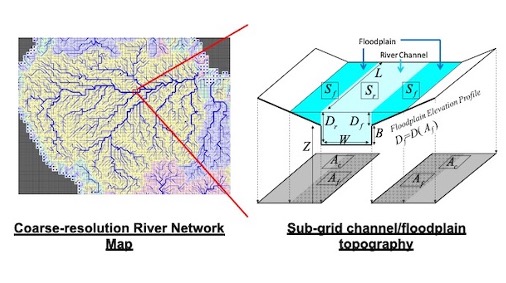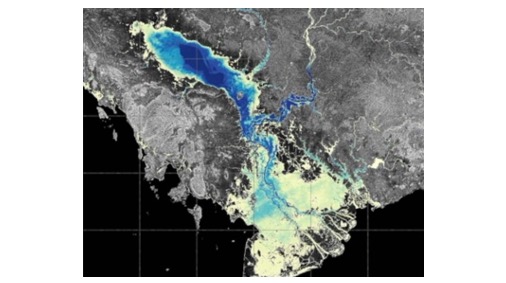CaMa-Flood annual briefing
CaMa-Flood annual progress briefing is a yearly event to review the achievements related to CaMa-Flood.
This is a new attempt from this year, and we will mainly introduce the achievements in 2022-2024.
The meeting was held on 14th March 2025, online on Zoom.
The progress report is available as PDF format and Video presentation.

CaMa-Flood Annual Progress Report
The Annual Progress Report 2024 is developed based on the input for CaMa-Flood annual briefing 2024. Thanks for all CaMa-Flood users/developers contributed to this annual report.
Download CaMa-Flood Annual Progress Report 2024
About the CaMa-Flood annual briefing
CaMa-Flood annual progress briefing is a yearly event to review the achievements related to the global river model CaMa-Flood. This will be an opportunity for CaMa-Flood users/developers/contributors to advertise their achievements, and also a chance to enhance research network.
The briefing starts with the summary of the key progress report by the core developer team. Then, CaMa-Flood users have opportunity for introducing their achievements in a short-talk series. We are also thinking about having 1-2 invited talks for highlighting important achievements.
The primary purpose of the annual briefing is to make a catalogue of CaMa-Flood researches, and make it visible to CaMa-Flood communities and outward. We’d like to ask CaMa-Flood users/contributors to make a short summary on their achievement (1-2 page), and generate “CaMa-Flood annual progress report” by collecting these summaries. Also, we will record presentations during the online meeting and make it as “video report”.
Note: We are also planning to have CaMa-Flood user/developer meeting every two years, which prioritize discussion on frontier topics and future directions. The annual briefing primary focuses on summarizing the recent achievements. Of course, networking of CaMa-Flood user community is the most important purpose in the both meetings.
Important dates and deadlines
(For attending)
- Registration for online meeting: always open
- Meeting date: 14 March
(For presenting your achievement)
- Registration for presentation: by 21 February (extended)
- Submission of 2 page summary: by 28 February
- Annual report appears by the end of March
- Note: Achievement summary format is shared with registered presenter by email.
(For those who want to present, but cannot join on 14 Mar)
- Deadline for video recorded talk: 7 March
Note for presenters
The meeting is for sharing the achievements related to CaMa-Flood in 2022-2024. Thus, we assume you published your work in advance (journal publication, online documents, or web contents), and provide the summary of that work in the meeting. (If not yet published, you can introduce it in next year).
Any achievements related to CaMa-Flood can be introduced.
- Development of a new scheme or tool for CaMa-Flood
- Applicational studies using CaMa-Flood, such as flood risk assessment
- New data or tool which is helpful for CaMa-Flood
- Use of CaMa-Flood in climate/weather services (operational, business, etc).
If you are not sure your achievement fits to the scope, please just ask the meeting organization team (yamazaki [at] iis.u-tokyo.ac.jp). As this is the first annual briefing event, we accept achievements for past years. We focuses primary on 2023-2024, but earlier works are also welcomed.
We will ask all presenters to prepare 2-page summary of your achievement, which will be published as “CaMa-Flood annual progress report”. We will share GoodleDocs URL for online edit, or you can just send the MS Word file by email. Deadline for 2 page summary is 28th February.

Meeting Info
Date and location
The CaMa-Flood annual progress briefing 2024 will take place on 14th March 2025 (Friday), Online on Zoom.
Tentative Meeting Time
Tentative meeting time is 11AM - 1PM in GMT (2 hours) on 14 March, but might change depending on number of presentations.
- 8:00PM - 10:30PM in Tokyo, Japan
- 4:30PM - 7:00PM in New Delhi, India
- 11:00AM - 1:30AM in London, UK
- 7:00AM - 9:30AM in Washington DC, US
Schedule
- Opening (Dai Yamazaki): 5min
- Report on major update (CaMa-Flood core development team): 15min
- Report on achievements (CaMa-Flood contributors): 5-6 min each
- Invited highlight talk on important achievements: 10 min each
- Announcement on next events
- Closing
Video on CaMa-Flood development
Yamazaki received AOGS Kamide Lecture Award (Hydrology Section), and made a lecture talk in in August 2021. The recorded talk is available on “YouTube”
Related Meeting
AOGS Large-River Modelling Session
We will organize a Large-scale River Modeling session in AOGS2025.
The meeting is through 27 July to 1 August in Singapore. Please consider joining, and I’m looking forward to meeting you there.
AOGS2025 meeting webpage
The abstract submission deadline is 18 February.
(Session Info)
HS09: Advances in Large-scale River Modeling: Developments and Applications
Conveners:
- Dr. Dai Yamazaki (The University of Tokyo)
- Dr Peirong Lin (Peking University)
- Dr Fitsum Woldemeskel (Bureau of Meteorology)
- Dr Xudong Zhou (Ningbo University)
Scope:
Large-scale river modeling has continuously evolved in recent years. This evolution is due to many factors such as better conceptualization of river flow physics, new schemes to represent river infrastructures, advancement of baseline geography data like elevation and river networks, and increasing computational resources. These advancements enabled more advanced applications of large-scale river models, such as global-scale flood risk assessment, real-time flood forecast on the continental scale, coupling with Earth system models, and integration of satellite river observations into models through data assimilation. In this session, we welcome any research topics related to the development and/or applications of large-scale river models. New scientific discoveries obtained from large-scale river modeling and/or local decision-support applications are also welcome to submit. We will review the frontier research on large-scale river modeling and discuss next challenges and future directions.
Next CaMa-Flood user/developer meeting
We are thinking about having the 2nd CaMa-Flood user/developer meeting in Summer-Autumn 2026. The meeting plan is under consideration now. Please wait for a while.
CaMa-Flood annual briefing: Logistics
Organizing Committee
As of January 2025
- Dai Yamazaki (Chair, UTokyo)
- Zhou Xudong (Ningbo Univ)
- Gang Zhao (Science Tokyo)
Please email to Dai Yamazaki ( yamadai [at] iis.u-tokyo.ac.jp ) and/or Xudong Zhou (x.zhou [at] rainbow.iis.u-tokyo.ac.jp ) for question about the meeting.
Program of online briefing on 14 March
note: times are in Japanese time zone (GMT +9)
[20:00 - 20:20] 1. Status of CaMa-Flood core developments [20 min]
[G1] Major Updates of CaMa-Flood in 2022-2024
Dai Yamazaki [12min]
[G2] CaMa-Flood accuracy evaluation
Xudong Zhou [8min]
2. CaMa-Flood achievement reports
[20:20-20:50] 2A: Highlight of milestone papers [6min * 4 talks]
[A1] Global Flood Risk under Climate Change / Global exposure to flooding from the new CMIP6 climate model projections
Yukiko Hirabayashi, et al. 2013, Nature Climate Change Yukiko Hirabayashi, et al. 2021, Scientific Reports
[A2] The critical role of the routing scheme in simulating peak river discharge in global hydrological models
Fang Zhao, et al. 2017, Environmental Research Letters
[A3] Local floods induce large-scale abrupt failures of road networks
Weiping Wang et al., 2019, Nature Communications
[A4] Role of dams in reducing global flood exposure under climate change
Julien Boulange et al., 2021, Nature Communications
[20:50-21:25] 2B: CaMa-Flood development papers [5min *6 talks]
[B1] Assimilation of transformed water surface elevation to improve river discharge estimation in a continental-scale river
Menaka Revel,et al. 2023, Hydrology & Earth System Sciences
[B2] A globally applicable framework for compound flood hazard modeling
Dirk Eilander et al., Natural Hazard & Earth System Sciences
[B3] Inundation prediction in tropical wetlands from JULES-CaMa-Flood global land surface simulations
Toby Marthews et al., Hydrology and Earth System Sciences, 2022
[B4] A New Generation of Hydrological Condition Simulator Employing Physical Models and Satellite-based Meteorological Data
Wenchao Ma et al., Earth and Space Science, 2024
[B5] Multivariable Integrated Evaluation of Hydrodynamic Modeling: A Comparison of Performance Considering Different Baseline Topography Data
Prakat Modi et al., Water Resources Research, 2022
[B6] Correction of River Bathymetry Parameters Using the Stage–Discharge Rating Curve
Xudong Zhou et al. 2022, Water Resources Research
[21:25-22:05] 2C: CaMa-Flood application papers [5min * 7talks]
[C1] Quantifying the relative contributions of climate change and ENSO to flood occurrence in Bangladesh
Shahab Uddin, et al. 2023, Environmental Research Letters
[C2] Uncertainty of internal climate variability in probabilistic flood simulations using d4PDF
Yuki Kita, & Dai Yamazaki, 2023, Hydrological Research Letters
[C3] Methodology for constructing a flood - hazard map for a future climate
Yuki Kimura, et al., Hydrology and Earth System Science, 2023
[C4] Reconstruction of long-term hydrologic change and typhoon-induced flood events over the entire island of Taiwan
Jac Stelly, Amar Deep Tiwari et al., Journal of Hydrology: Regional Studies, 2024
[C5] Climate change and urban sprawl: Unveiling the escalating flood risks in river deltas with a deep dive into the GBM river delta
Shupu Wu et al., Science of the Total Environment, 2024
[C6] Substantial increase in future fluvial flood risk projected in China’s major urban agglomerations
Ruijie Jiang et al. Communications Earth & Environment , 2023
[C7] Flood risk assessment for Indian sub-continental river basins
Urmin Vegad et al. 2024, Hydrology and Earth System Sciences
[22:05-22:25] 2D: New data/tool for CaMa-Flood [5min * 3talks]
[D1] AllocateRiverGauge tool v1.0
[D2] AltiMaP: altimetry mapping procedure for hydrography data
Menaka Revel et al. 2024, Earth System Science Data